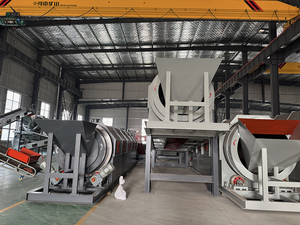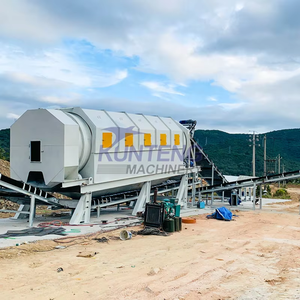(66 products available)

















































































































































































































































A waste concrete recycling system is an industrial machine used to crush waste concrete into smaller reusable pieces. Several different types of waste concrete recycling systems are available to meet buyers' needs.
Portable Concrete Recycling Machine
This type of recycling machine is designed to be transported easily from site to site with standard delivery trucks. It is not heavy and has small dimensions that allow it to be installed at a variety of locations where concrete crushing may be required. These mobile machines provide contractors and concrete producers with on-demand recycling capabilities. Once delivered to the waste site, the portable machine can immediately begin processing the broken concrete into recycled aggregate. No extra equipment or connections are needed for setup. Their transportability allows them to be used wherever excess concrete needs to be economically and sustainably reduced by onsite crushing and recycling.
Mobile Concrete Recycling Plant
A mobile concrete recycling plant differs from portable options in having plant-like features. It possesses a concrete mixer that allows for recycling by mixing and then refashioning the concrete into useful, new segments. The mobile nature of the facility means it can process waste material at the origin of generation, eliminating lengthy transport of debris. This not only saves cost and time but significantly reduces environmental impact in terms of further cut down on fuel consumption and emissions. As treatment occurs on location, landfills are spared from one more contributor. Such plants turn trash into resources closer to home. Their flexibility meets local needs while safeguarding the planet better than the old ways.
Tracked Concrete Crusher
This type of concrete recycling machine has a chassis that is driven by tracks, providing superior mobility on uneven waste sites. The tracked contraption can easily traverse the difficult, rugged terrain commonly found where concrete debris is generated. Its track system offers stable, reliable movement in all directions to position exactly where needed for crushing operations. This all-terrain ability means the machine does not have to rely on auxiliary equipment or long transport distances to access work areas. The tracked concrete crusher can directly follow the construction activity, wherever that may be, minimizing material handling time. By being able to move close to the source of waste generation, the tracked machine enhances efficiency by reducing the distance and downtime associated with material transport.
Understanding the specifications of a waste concrete recycling machine helps one know how best to operate and maintain it. These include material, dimensions, throughput, and motor power, among others.
Regular maintenance helps to keep the recycling machine in top shape and working well. Here are some concrete recycling system maintenance tips.
Concrete waste recycling systems have diverse usage scenarios across different industries. The construction industry is the primary sector where concrete waste recycling systems are used. The systems are installed on construction sites and at ready-mix batching plants to handle concrete waste effectively when carrying out new builds, renovations, or demolitions.
Infrastructure development projects, such as the building of roads, bridges, and tunnels, present additional opportunities for the use of concrete recycling systems. Infrastructure projects frequently generate large amounts of concrete debris that must be recycled to keep costs down and comply with environmental regulations.
Concrete waste recycling systems are employed at municipal waste treatment facilities to process discarded concrete and separate reusable components. Landfills may install concrete recycling systems on-site or collaborate with mobile service providers to process concrete waste on-site, thereby reducing the volume of waste entering the landfill.
Additionally, the production of new concrete involves the use of recycled concrete aggregate in place of or alongside natural aggregate. Concrete recycling makes this possible. Concrete waste recycling systems are standard in precast concrete factories since they turn concrete debris into recycled aggregates that can be employed in precast concrete goods.
Finally, masons frequently deal with small quantities of concrete waste. Concrete recycling solutions for them are accessible, allowing them to recycle leftover concrete from their jobs and reduce their environmental impact.
Business buyers searching for a good waste concrete recycling system must consider different factors. The machine's capacity impacts its ability to handle concrete waste volumes effectively. Buyers should assess their site's space and ensure the machine can fit there. The ease of operating the system is fundamental to minimizing training costs and downtime. Also, clients prefer machines that require minimal maintenance and are built to last. Concrete recycling systems with high energy-efficiency levels help to cut operational costs.
Finally, buyers should consider machine models compatible with various types of concrete waste. Waste segregation capabilities are important since not all concrete materials can be recycled. Concrete recycling systems with good waste segregation features streamline the recycling process. Also, systems with automated functionalities help minimize manual segregation efforts.
Concrete recycling machines are expensive, so buyers should opt for models with robust build quality. These machines will last for many years under constant use. Buyers should research the machine's processing technologies before buying. The most advanced systems have technologies that produce high-quality recycled aggregates. Buyers are advised to get machines that comply with local environmental regulations to avoid legal penalties. More importantly, buyers need to source machines from reputable manufacturers who offer good warranties and excellent customer support services.
Q1: How much recycled aggregate can a waste concrete recycling system provide?
A1: The capacity depends on the plant's size and processing ability. Small-scale systems might recycle a few tons daily, while larger plants could handle hundreds of tons each day.
Q2: What type of concrete crusher is used in a waste concrete recycling system?
A2: Several kinds, including jaw crushers, impact crushers, cone crushers, and electric-powered concrete crushers, are commonly used.
Q3: What factors affect the cost of a waste concrete recycling system?
A3: Waste concrete recycling systems' costs are affected by capacity, technology, automation level, material processing, custom features, and additional separation.
Q4: What are the latest trends in waste concrete recycling systems?
A4: The latest trend is increasing automation and smart technology, allowing remote monitoring and control of the recycling process. Higher separation accuracy is also pursued, enabling the recovery of more valuable materials.